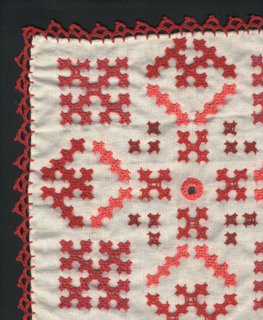
In India, with her rich and varied culture and traditions – craft flourished thanks to royal patronage. Embroidery in the different regions of India, is as rich, distinctive, varied and colourful as the people inhabiting it.
The embroidery of Kutch and its neighbouring Saurashta is colourful. It flourished in the late 19th and 20th centuries. It employs simple stitches like the herringbone, buttonhole, chain and open chain stitches. The interlacing stitch (looping around the double herringbone stitch) and the Maltese Cross are predominant. These are embellished with mirrors and sometimes even shells.
Geometric motifs are built using the Maltese Cross and Interlacing stitch. A truly amazing combination patterns are churned out. Once the basic “overs” and “unders” of the interlacing are mastered, even a beginner can execute this embroidery with relative ease.
Now, here is the interesting part – The Maltese cross and the Interlacing stitch are also predominantly used in Armenian Embroidery. There are very clear instructions for drawing the motifs and interlacing.
Armenia, is a small pocket north east of Turkey.
Some researchers believe that the interlacing stitch was brought to the Kutch region by Arab traders – that the stitches were characteristic of traditional Sindhi embroidery (Kutchwork) practiced widely by immigrants from Sind and Baluchistan (western Pakistan).
Maybe the stitches originated in the Arab nations of Iraq and Iran, spread upwards to Armenia and downwards to the Sind region and to Kutch region in India.
No comments:
Post a Comment